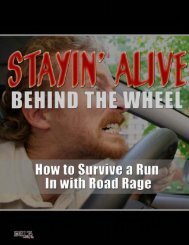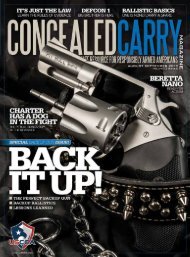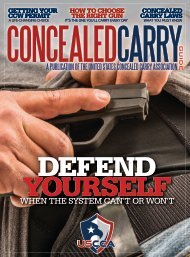Download This Issue - US Concealed Carry
Download This Issue - US Concealed Carry
Download This Issue - US Concealed Carry
You also want an ePaper? Increase the reach of your titles
YUMPU automatically turns print PDFs into web optimized ePapers that Google loves.
for many criminals. So I decided to go<br />
through the training and the range time<br />
and get my concealed carry permit.<br />
Let’s assume I have my concealed<br />
carry permit and a firearm I am capable<br />
of using. What kind of duty to retreat<br />
does a person have in relation to the use<br />
of deadly force? <strong>This</strong> will vary by state.<br />
Some states have no duty to retreat. You<br />
may need to check with an attorney in<br />
your own state to discover the applicable<br />
law. A person’s ability to retreat will<br />
be evaluated on a case-by-case basis,<br />
depending on the person’s physical and<br />
mental capabilities. As is more common<br />
in the southern states, in Arkansas<br />
I have a duty to retreat under the law<br />
unless I am in my own home. However,<br />
my own ability to retreat is very limited<br />
because of my physical disability and so<br />
my duty to retreat would be evaluated<br />
based on that disability.<br />
What choices of weapons are available<br />
to me as a disabled person?<br />
Typically, a chemical spray (containing<br />
tear gas, a combination of tear gas and<br />
pepper spray, or pepper spray alone), a<br />
Taser (with a clean background check),<br />
a stun gun, or a firearm. The legality of<br />
each of the items listed varies by state<br />
and locality. Massad Ayoob, an expert in<br />
the use of firearms for law enforcement<br />
and self-defense, sums up the choices<br />
this way: “Guns are the only weapons<br />
that put a physically small or weak person<br />
at parity with a powerful, very possibly<br />
armed, criminal.” 6 That leaves a<br />
firearm as the most practical choice for<br />
a person with a disability. As with any of<br />
the above self-defense choices, hopefully,<br />
a person (especially a disabled<br />
person) can discharge the weapon accurately<br />
and effectively to avoid either<br />
being disarmed or attacked by the assailant.<br />
Fortunately, I have never had to<br />
find out.<br />
A disabled person will have more<br />
problems choosing a firearm than a<br />
Just who exactly is this sign protecting?<br />
non-disabled person. For example, in<br />
my situation, it would be impossible for<br />
me to use a shotgun to defend myself<br />
inside my own home. I have four fused<br />
discs in my neck. I would not be able to<br />
tolerate the recoil from a shotgun, so I<br />
must use a handgun instead. The questions<br />
I had to ask myself in selecting a<br />
handgun were:<br />
1) Do I have sufficient grip strength to<br />
be able to hold the gun?<br />
2) Can I hold the weight of the gun?<br />
3) Do I have sufficient finger strength to<br />
pull the trigger?<br />
4) Can I remember to disengage the<br />
safety when I need to?<br />
5) Can I physically disengage the<br />
safety?<br />
6) Do I have sufficient hand strength<br />
and control to load a magazine, put it<br />
into the gun, and remove it from the<br />
gun?<br />
7) Do I have sufficient hand strength<br />
and control to pull the slide back?<br />
8) Can I physically engage the safety?<br />
The answers to the above questions<br />
lead directly to the choice between an<br />
automatic pistol or a revolver. When I<br />
first purchased a handgun, I bought an<br />
autoloader. I was able to perform the<br />
critical tasks listed above. As time has<br />
passed, my ability to control my arms,<br />
hands, and fingers has decreased. I am<br />
reaching the point where an automatic<br />
is no longer a practical choice for me.<br />
Before too much longer, I will need to<br />
test and purchase a revolver.<br />
I cannot emphasize enough if you<br />
have a disability that affects the control<br />
and strength of your arms, forearms,<br />
wrists, hands, and fingers, make sure<br />
you go to a gunshop which will actually<br />
allow you to try the pistol before you<br />
buy it. On paper, any pistol will look like<br />
it will work, but don’t risk several hundred<br />
dollars on it. If you are disabled,<br />
you need to practice shooting with<br />
your pistol more than a non-disabled<br />
person would. It may be more difficult<br />
for you to learn the proper procedures<br />
for loading and unloading your pistol<br />
because of the pain, medication, or<br />
other distractions you have. I am guilty<br />
as charged on this. I don’t practice as<br />
much as I should.<br />
If you live in a state where concealed<br />
carry is allowed, one question you need<br />
to ask yourself is, “Where am I going to<br />
conceal the pistol?” If you use a wheelchair,<br />
a fanny pack designed for that<br />
purpose may be your best bet. 7 If you<br />
use crutches or a walker, then where to<br />
conceal the pistol and be able to access<br />
1. Bruce N. Eimer. “Coping with Physical Disability in <strong>Concealed</strong> <strong>Carry</strong> and<br />
Defensive Handgun Training” <strong>Concealed</strong> <strong>Carry</strong> Magazine 4 (February/<br />
March 2007): 38-42.<br />
2. Gregor Wolbring. “Violence and Abuse in the Lives of People with Disabilities”<br />
International Centre for Bioethics, Culture, and Disability (1994): 1-5 www.<br />
bioethicsandsiability.org/violence.html (Accessed November 9, 2007).<br />
3. Martin Wainwright. “Jail for ex-soldier who urinated on dying disabled<br />
woman” The Guardian (October 27, 2007): 1-3 www.guardian.co.uk/crime/<br />
article/0,,2200320,00.html (Accessed November 9, 2007).<br />
4. Randy LaHaie. “The Nuts & Bolts of Awareness: Learning To Detect Trouble”<br />
Self-Defense Articles (2002): 1-8 www.protectivestrategies.com/awareness.<br />
html (Accessed November 9, 2007).<br />
5. “<strong>Concealed</strong> <strong>Carry</strong>” Pennsylvania Firearms Owners Association (February 25,<br />
2007): 1 www.pafoa.org/concealed-carry/ (Accessed November 12, 2007).<br />
6. Massad F. Ayoob. In the Gravest Extreme: The Role of the Firearm in Personal<br />
Protection. (Concord, New Hampshire: Police Bookshelf, 1980): 38.<br />
7. Bruce N. Eimer. “Bear Arms In A Wheelchair” <strong>Concealed</strong> <strong>Carry</strong> Magazine 2 no.<br />
8 (November/December 2005): 28.<br />
8. Bruce N. Eimer. “Bear Arms In A Wheelchair” <strong>Concealed</strong> <strong>Carry</strong> Magazine 2 no.<br />
8 (November/December 2005): 28-9.<br />
9. Carolyn Boyles. A Complete Plain-English Guide to Living with a Spinal Cord<br />
Injury: Valuable Information From A Survivor (Lincoln, Nebraska: iUniverse,<br />
2007): 305.<br />
34<br />
<strong>US</strong>CONCEALEDCARRY.COM n CONCEALED CARRY MAGAZINE n JULY 2008
















